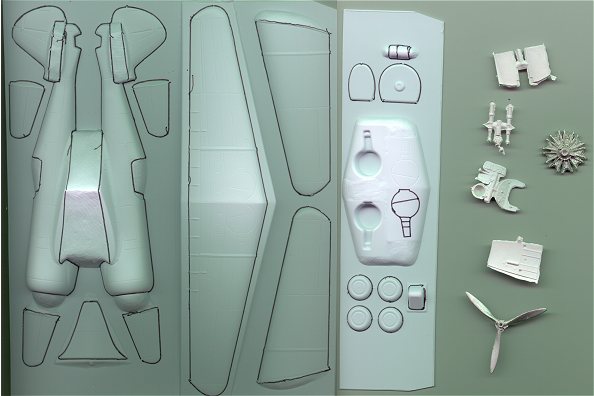
|
KIT: |
Sierra 1/48 Curtiss-Wright CW-21 |
|
KIT # |
48-43 |
|
PRICE: |
$27.95 |
|
DECALS: |
One aircraft |
|
REVIEW & |
|
|
NOTES: |
Vacuform with white metal and injected bits.` |

|
HISTORY |
The Curtiss-Wright CW-21 was designed as a bomber interceptor for overseas export. Derived from the company’s two-seat CW-19/SNC-1 Falcon, it was lightweight and had (for the day) a phenomenal rate of climb. Dubbed the "Mile a Minute Interceptor", it was powered by a 1000 hp Wright R-1820-G5 radial and could attain speeds of up to 315 mph. Armament consisted of two .30 cal and two .50 cal machine guns, all mounted in the nose and firing through the propeller arc.
Thirty-nine CW-21’s were ordered by the Chinese government in 1939, but only four of these were ever built (and all four crashed, three of them killing AVG pilots ferrying them to Rangoon). A further 24 of the CW-21B (distinguished by its inward retracting main gear) were ordered by the Netherlands in 1940. Completed five months after the Netherlands fell to the Nazis, these were diverted to the Netherlands East Indies, where they formed the 2nd Fighter Squadron defending Java.
Inadequate armor, lack of self-sealing fuel tanks and inexperienced pilots combined to make the Dutch fighters easy marks for the invading Japanese. Most were lost in dogfights for which they had not been designed. Several examples were captured and evaluated in Japanese markings, but none survived the war.
|
THE KIT |

This is another vacuform I picked up at the IPMS/USA Nationals in July. Made by Sierra Scale Models
it consists of:
The vacuformed parts provide fuselage halves, wing halves, wheels and various smaller bits. The molding is nice and sharp, with finely engraved panel lines and control surfaces, and decent raised detail. All detail is sharp and clean, and appears to line up across the halves of various parts. The two crystal clear canopies have very faint framing detail and a slightly pebbly texture that should be easily taken care of by polishing and future.
The metal pieces are also well cast and should require minimal clean up. The plastic parts, however …. These make up a very basic cockpit plus the spinner. They are heavily flashed and the detail is not spectacular.
Four detailed, well illustrated pages make up the instructions. These include
historical notes, references, photos and line drawings, as well as text that
walks one through assembly step-by-step . 
The small sheet of decals contain fuselage and wing insignia, plus numbers/letters to make any of the 2nd Fighter Squadron’s machines. Perfectly registered, they’re printed by Microscale, so they should be hassle-free to use.
Assembly, at least for the exterior, should be fairly straightforward. The instructions indicate you’ll need some scratchbuilding to build up the cockpit – or you can cheat by using a resin cockpit for an early P-40. I wasn’t able to find one of those, but I did pick up True Details P-40E cockpit, P-40 B/C wheels, and an Ultracast P-40 seat (all for dirt cheap), so I think I’ll be able to make up for any of the failings in the kit in these areas.
|
CONCLUSIONS |
I like it. This is a unique subject, and one we’re unlikely to see in this scale in any other media or by any other manufacturer. I’m going to go out on a limb here and propose that it might make a fin introduction to the world of vacuforms, due to it’s small size and simple construction. It’s certainly worth every penny I paid for it (especially since all those pennies were somewhat less than the retail price!). You can check out this kit and others by Sierra at their website: http://sierrascale.hypermart.net/
Review kit courtesy of my poor, long suffering wallet.
If you would like your product reviewed fairly and quickly by a site that averages thousands of visits a day, please contact me or see other details in the Note to Contributors.